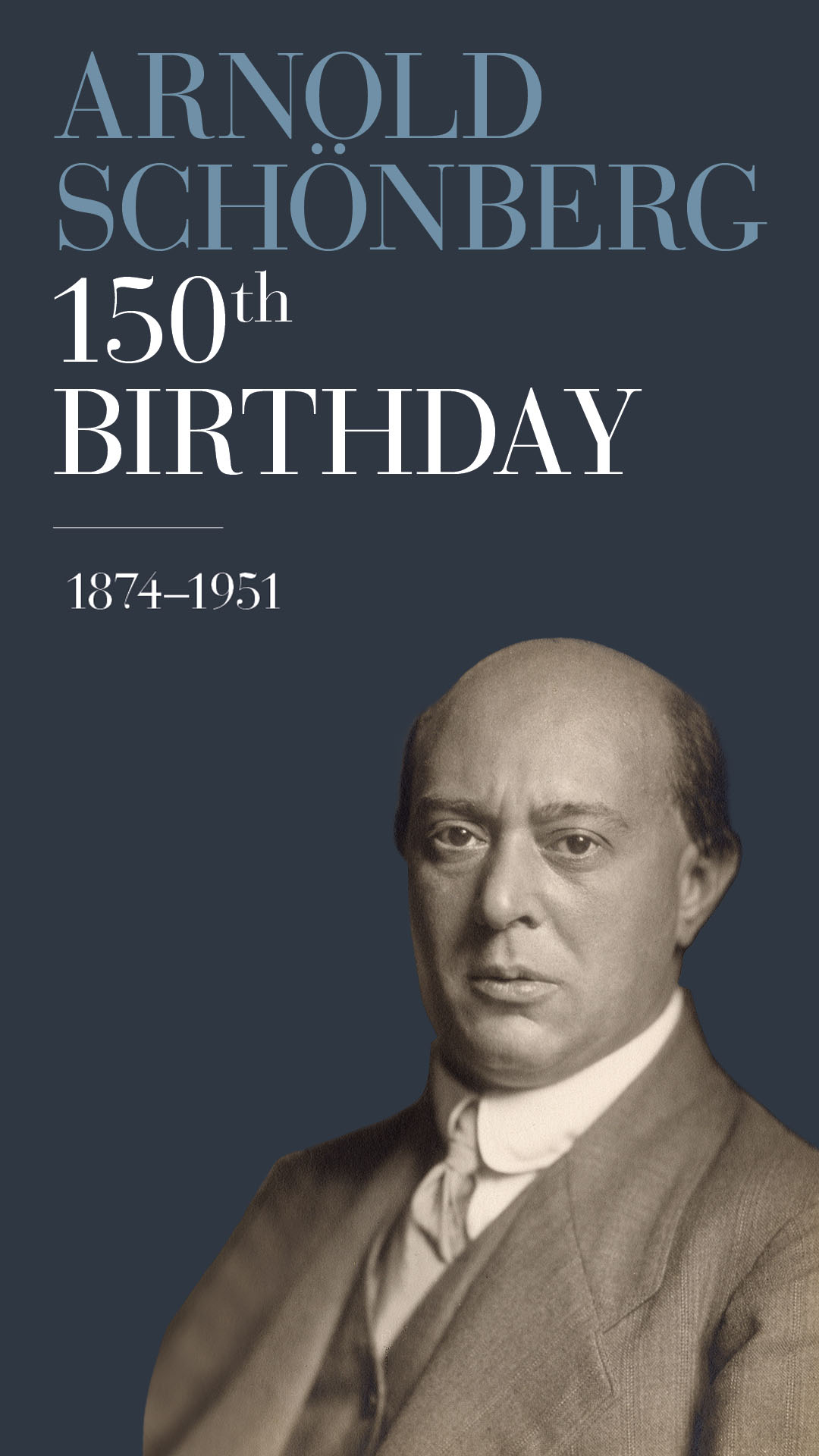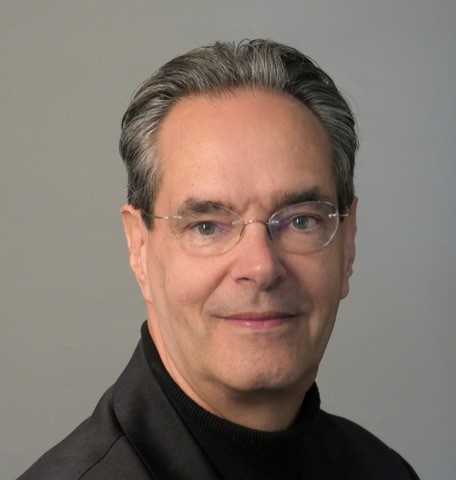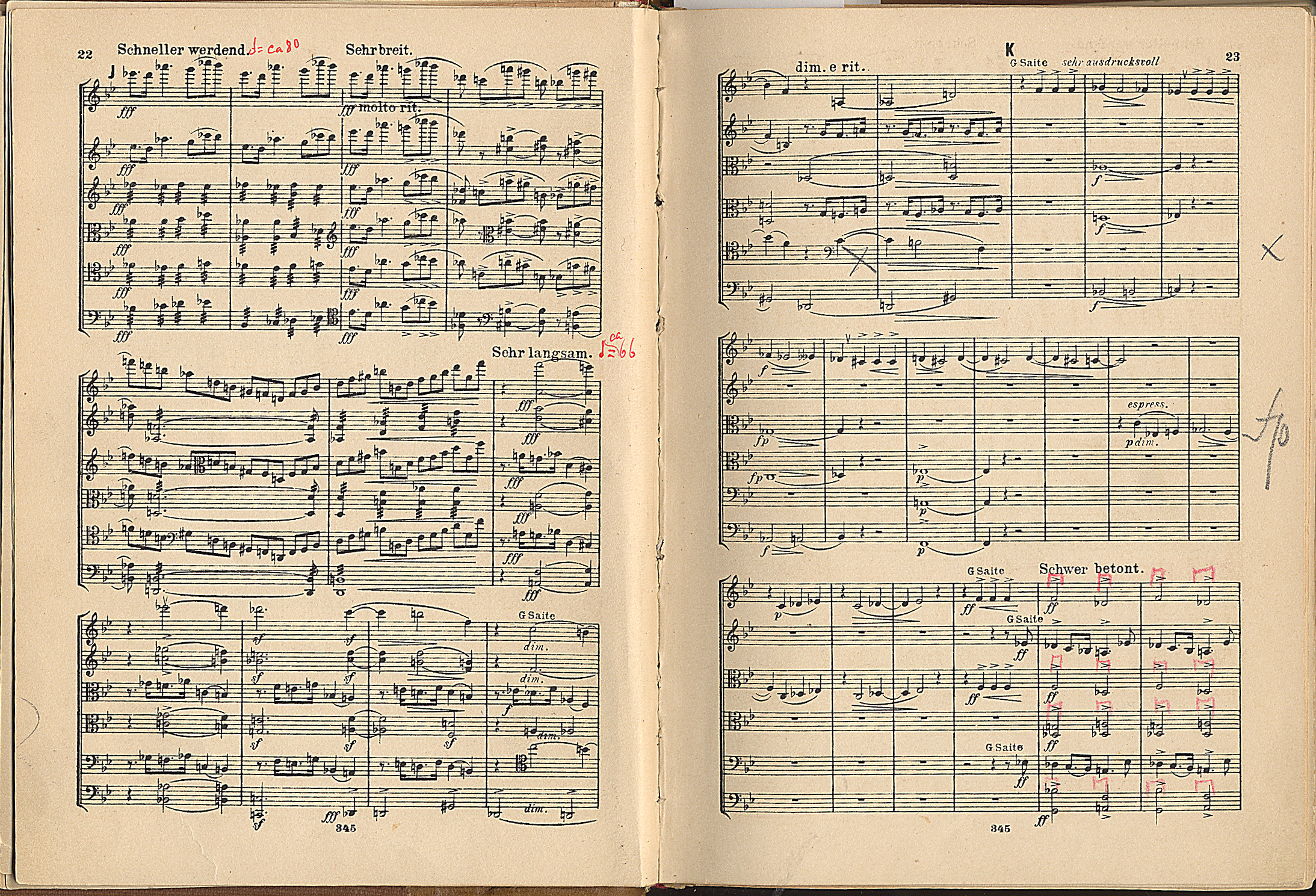Arnold Schönberg’s 150th birthday is duly  being celebrated by Henle: Promptly scheduled to start the year is one of his most popular works, Verklärte Nacht (Transfigured Night) for String Sextet (HN 1565), now also finally published in a blue Urtext cover. Assisting me with this edition project has been one of the Schönberg specialists par excellence, Henk Guittart, violist of the former Schönberg Quartet, who has also conducted many performances of Verklärte Nacht. Even before I had begun work on the edition, he had already presented me with long lists of questions and corrections to the score resulting from his decades of familiarity with the work. We then exchanged over the past year countless emails reflecting on the source situation in general and on many score details in particular – because it was precisely in this area of tension between fidelity to the sources and practicability that we had to create a music text not only fulfilling the Urtext criteria but also providing performers with an optimal basis for making music. In the following interview we look back at why this was not so easy.
being celebrated by Henle: Promptly scheduled to start the year is one of his most popular works, Verklärte Nacht (Transfigured Night) for String Sextet (HN 1565), now also finally published in a blue Urtext cover. Assisting me with this edition project has been one of the Schönberg specialists par excellence, Henk Guittart, violist of the former Schönberg Quartet, who has also conducted many performances of Verklärte Nacht. Even before I had begun work on the edition, he had already presented me with long lists of questions and corrections to the score resulting from his decades of familiarity with the work. We then exchanged over the past year countless emails reflecting on the source situation in general and on many score details in particular – because it was precisely in this area of tension between fidelity to the sources and practicability that we had to create a music text not only fulfilling the Urtext criteria but also providing performers with an optimal basis for making music. In the following interview we look back at why this was not so easy.
Annette Oppermann (AO): Dear Mr Guittart, I would like to welcome you with a heartfelt ‘Thank-you’! Your contribution to our Schönberg edition is truly worth its weight in gold – thanks to your patience and perseverance in clarifying all the editorial details in our Urtext edition, we are now able for the first time to provide performers with much new and important information that we’d like to discuss in the following. But let’s start with a very personal question: when and how did you first encounter Schönberg’s Verklärte Nacht?
 Henk Guittart (HG): Dear Ms Oppermann, our collaboration was for me also very important and interesting! In answer to your question: I first heard Verklärte Nacht in 1971, at age 18, on a recording by Zubin Mehta conducting the Israel Philharmonic Orchestra. I still remember just how impressed I was and that this work, together with Pierrot lunaire (which, as a young violist, I rehearsed the same year in the predecessor to the Schönberg Ensemble that I later founded), led me, full of enthusiasm and fascination, to a lifelong love of Arnold Schönberg’s music.
Henk Guittart (HG): Dear Ms Oppermann, our collaboration was for me also very important and interesting! In answer to your question: I first heard Verklärte Nacht in 1971, at age 18, on a recording by Zubin Mehta conducting the Israel Philharmonic Orchestra. I still remember just how impressed I was and that this work, together with Pierrot lunaire (which, as a young violist, I rehearsed the same year in the predecessor to the Schönberg Ensemble that I later founded), led me, full of enthusiasm and fascination, to a lifelong love of Arnold Schönberg’s music.
AO: Verklärte Nacht occupied Schönberg for a long time: After initially thoroughly revising the Sextet (composed in 1899) for publication in 1905, he then created in 1916/17 a very successful first version for chamber orchestra. This entailed adding to the score a seventh (double bass) part, though leaving the basic music text essentially unchanged. In 1943 he revised it for a new American edition, wanting thereby to rectify the tonal shortcomings particularly pertaining to aspects of the earlier chamber-orchestra version’s tempo and articulation. But there were also pecuniary motives: the composer, banned from performances in Germany, had immigrated to the USA and received no royalties there from the (comparatively frequent!) performances of this orchestral work.

left: first edition of the version for Sextet (1905); right: first edition of the version for chamber orchestra (1943)
Today, this orchestral score, published in 1943, is regarded by many chamber musicians as an important source of information for producing the Sextet – one such chamber player is, for example, Henk Guittart, who has not only played and conducted the work countless times, but also recently arranged it for piano trio. Why is the 1943 version so important for the Sextet’s performance?
HG: Because it is, so to speak, Schönberg’s final word on this music. I am consequently also of the opinion that the early version from 1917 is superfluous or even invalid, meaning thus that such chamber orchestra performances do not represent the composer’s intention. The 1943 full score consists of a very large instrumentation, with at least 64 strings, by which Schönberg creates wonderful layers of sound, alternating between tutti and soloistic scoring, as well as also the original Sextet at times! All the corrections and changes he made in the 1943 score reveal his practical experience, most likely gained from sextet and orchestral performances, also as conductor. In my opinion, almost all the changes are purely musical improvements, with only very few having to do with the conversion of chamber music to that for a large ensemble. When in 1981 as an expanded Schönberg Quartet we first rehearsed the sextet version, it was clear to me that we should take the 1943 score as our point of departure. Walter Levin, first violinist of the LaSalle Quartet, later told us that his ensemble had also done the same. But I believe that so far only a few colleagues have followed us in this direction. I am convinced that the new Henle edition will help to ensure that the real improvements in Schönberg’s hand now become more widely known.
AO: In our Urtext edition, however, we have nonetheless opted for a clear distinction from the orchestral version, as Schönberg never expressed any doubts about the sextet score and even explicitly described the performers’ soloistic freedom in the chamber-music work as opposed to the orchestral version. We have made an exception in only one respect: the metronome markings. From the ‘very slow’ of the opening to the ‘very fast’ of the last section, the richly marked sextet score contains one or more tempo indications on almost every page, certainly raising questions about their exact implementation.
That Schönberg also considered more information useful here is documented by his personal exemplar of the sextet score, in which he entered metronome markings (alas, only up to measure 181). We have therefore included in our edition (with appropriate identification, of course) the complete metronome markings realised for the 1943 orchestral version as authentic practical performance information that also provides interesting comparative values for the sextet version.
On the other hand, I couldn’t decide to take on the fundamental revision of dynamics and articulation – which you, Henk Guittart, felt made sense. How so?
HG: Because I firmly believe that the 1943 version contains many improvements, especially in terms of articulation and dynamics. Although I fully understand, of course, that these changes cannot be incorporated within an Urtext edition of the Sextet.
AO: Especially as this would have meant that we would no longer have been able to show the sextet version’s authentic layer of dynamics and articulation – which is definitely not compatible with the Urtext idea. Hence, only in exceptional cases did I consult the late orchestral version in my edition.
But your perspective on the work also convinced us. And so, we have opted for a completely new solution in the digital version of our Verklärte Nacht Urtext edition. Here, in the appendix, you provide our users with a marked version of our Urtext score that is more closely based on the 1943 orchestral version. What principles did you thereby follow, Mr Guittart?
HG: The dynamics and articulation are almost completely taken over from the 1943 score, the criterion in each case being whether the change would also be appropriate for the chamber-music version. There were only a few exceptions. In my opinion, this makes the sextet version even clearer and more pellucid. I was also glad to adopt the indication of passages with primary or secondary importance introduced by Schönberg in the late orchestral version, because it really promotes transparency.
AO: In order to capture clearly the differences from the original text in this version as well, we have ventured an experiment: marking the changes in red. Very laborious in printing, but comparatively easy – after a few attempts – to produce in digital form.
But we should also reveal that this appendix score contains a few practical tricks.
HG: Yes, for example, I added a diminuendo sign in the viola I, measures 47 and 49. Until recently, I could only justify this by saying that I found it musically appropriate. But since I heard the 1929 recording conducted by Schönberg himself, I believe even more firmly that it does no harm to add it as a recommendation.
In measure 330, I believe that the last note in viola I should be g flat1, not e flat1. I’ve always played it that way because to me it seemed logical. But that’s not found in any source. But now it can be read in my score.
AO: Yes, this is one of the rare cases where even a pitch has been changed in the appendix score. In the Urtext edition, on the other hand, it is e-flat1, but with a reference to the Comments, where explained is that the interval of a 10th to the 1st pitch of the descending scale (instead of the octave interval as usual in mm. 330f.) is unusual and possibly a writing error by Schönberg running through all the sources, right up, incidentally, to the 1943 orchestral version!
HG: Then, there are also passages in my appendix score specifically recommending an easier execution. Although I think that the composer is always right in principle, I cannot understand why the cellos should change the double stops in measure 226, when all the other instruments don’t. It doesn’t alter the colour, only giving a possible instability for both cellos. That’s why I suggest a part change here that solves the problem.
Practically speaking, I would also recommend a different solution for the chord in measure 416: the a1 of violin I could be taken over by viola I, whose a2 could be taken over by violin I. This would avoid the fifth in the viola, which is sometimes unpleasant in this high register, and the open A string of violin I, which might be too low (after about half an hour), would no longer be a problem. Such suggestions are not in my score, because in my opinion that would be too much of a change. But I am happy to mention them here as insider tips for attentive readers of this blog post….
AO: Many thanks for that! So, have all your questions about Verklärte Nacht been answered? Or are there still places for which you cannot find a conclusive answer?
HG: Yes! I don’t really understand what Schönberg meant by the forte in measure 21. Measure 20 is indeed already forte and then a crescendo to forte? Does that mean subito meno forte on the first beat of measure 21? We tried that once, and then it really sounds a bit overdone. Or does it indicate a climax? That’s how I perceive it – and I only recently discovered that it also sounds like that in Schönberg’s recording from 1929. But ultimately the notation remains enigmatic!
AO: And with this enigma, we conclude this blog post on our special edition of Verklärte Nacht. Warm thanks for this interview!








